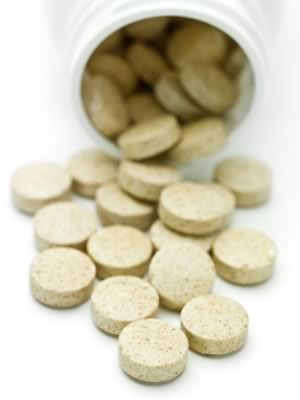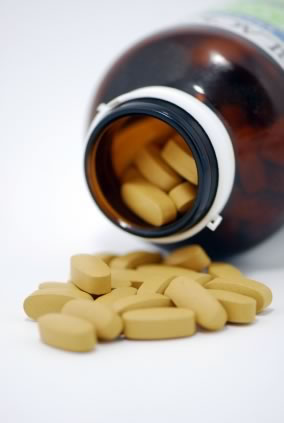Vitamin B5, or pantothenic acid, is an unstable viscous oil that is sensitive to acids, bases, and heat. It is biologically active in the forms of coenzyme A (CoA) and acyl carrier protein. It is an essential nutrient that’s crucial to a number of life-sustaining reactions in the human body. One of the B vitamins, pantothenic acid, or B5 is found in virtually every food source. In fact, the name pantothenic acid is derived from the Greek word pantos which means “from everywhere.”

Vitamin B5 goes by a number of different names, which can make it difficult to clearly identify if the nutrient is present in a particular food, medicine, or cosmetic preparation. Generally, if any of the following ingredients are listed, the nutrient is present:
- Vitamin B5
- VitaminB-5
- B Complex Vitamin
- Coenzyme A
- Pantothenic Acid
- Calcii Pantothenas
- Calcium D-Pantothenate
- Calcium Pantothenate
- D-Calcium Pantothenate
- D-Panthenol,
- D-Pantothenic Acid
- D-Panthenol
- D-Pantothenyl Alcohol
- Panthenol
- Pantothenate
- Pantothenic Acid
- Pantothenol
- Pantothenylol,
- Dexpanthenol
- Dexpanthenolum
- Calcii pantothenas
- C9H17NO5
- D (+)- N -(2,4-dihydroxy-3, 3-dimethylbutyryl)-beta-alanine
- D(+)-pantothenic acid
It can be most often found in commercial supplements as D-pantothenate (D-calcium pantothenate). Dexpanthenol is considered a provitamin form of the nutrient and is the alcohol of pantothenic acid. Dexpanthenol is used in various cosmetic products and is available in topical treatments to promote wound healing.
B5 in the Body
B5, or pantothenic acid is necessary for the human body’s chemical reactions that generate energy from food. In addition to serving an important role in releasing energy from foods, B5 in the form of CoA is also important for the synthesis of foods into fatty acids and cholesterol, as well as the creation of sphingosine. This fat-like molecule plays an important role in delivering chemical messages inside the body’s cells. Finally, B5, in its CoA form, is needed for the liver to safely metabolize several drugs and toxins.
Because pantothenic acid is in the form of Coenzyme A in most food sources, the body has to convert it into free pantothenic acid so that it can be absorbed by the intestinal cells. This conversion takes place within the lumen of the intestine where CoA is hydrolyzed A through a series of enzymatic reactions to produce pantothenic acid which is then absorbed by passive diffusion into the intestinal cells by a sodium-dependent transport system.
Dietary Needs
The Institute of Medicine at the National Academy of Sciences set adequate intake guidelines for B5 in 1998. According to those guidelines, recommended average daily intakes of pantothenic acid should range from 5 to 6 mg. per day in adults.
Vitamin B5? Get Remedies Fast!
It is noteworthy that the human body’s need for the nutrient increases with age as indicated below:
Age Required mg/day
- 0-6 months 1.7
- 7-12 months 1.8
- 1-3 years 2
- 4-8 years 3
- 9-13 years 4
- 14-18 years 5
- 19+ 5
In addition, women who are pregnant should get 6 mg. each day. Women who are breast-feeding should ensure a daily intake of 7 mg. daily. Except in the case of extreme malnutrition, most people get adequate amounts of B5 or panthothenic acid through a healthy, balanced diet.
The symptoms of vitamin B5 deficiency are much like other B vitamin deficiencies. Because of low Coenzyme A levels there is low energy production, which can in turn causes fatigue, irritability and general apathy. In addition a deficiency in panththenic acid may also result in increased insulin sensitivity, or hypoglycemia.
Pantothenic acid sources
Approximately 85 percent of pantothenic acid found in food sources is present in the form of coenzyme A. There are several food sources that are rich in vitamin B5 including kidney, liver, avocado, yogurt, and sunflower seeds. Other foods such as fish and shellfish, chicken, milk, sweet potato, mushrooms, legumes, avocado and sweet potatoes are also excellent sources of the nutrient.
Although whole grains are also a good source of pantothenic acid; up to 75 percent of the nutrient can be lost in processing since it is largely found in the outer components of raw grains. Likewise, because it is a water-soluble nutrient, up to 50 percent of pantothenic acid in food is lost in processing and cooking.
The following provides a quick look at some of the richest sources of pantothenic acid:
- Food Serving Size B5 (mg)
- Calf’s Liver (braised) 4 oz. 2.59
- Sunflower Seeds (raw) ¼ C. 2.43
- Avocado 1 whole 1.99
- Low-fat Yogurt 8 oz. 1.35
- Yellow Corn (cooked) 1 Cup 1.44
- Chicken (cooked) 3 oz. 0.98
- Milk 8 oz. 0.83
- Winter Squash (baked) 1 Cup 0.72
- Mushrooms ½ C. chopped 0.52
In addition to occurring naturally in many foods, B5 is frequently found in combination with the other B vitamins in commercially available B Complex formulas, which also include thiamin (B1), riboflavin (B2), Niacin (B3), Pyridoxine (B6), cyanocobalamin (B12), and folic acid.
Finally, researchers have found that the bacteria that normally colonize the colon, or large intestine, are capable of manufacturing their own pantothenic acid.
Unfortunately, scientists are not yet certain if humans have the capability to absorb the pantothenic acid that is produced by their own intestinal bacteria. Even so, a specialized process for the uptake of pantothenic acid has been identified within cultured cells taken from the colon’s lining. This suggests that humans may indeed be able to absorb the pantothenic acid produced by their intestinal bacteria.
B5/pantothenic Acid in Use
The therapeutic and medicinal uses for pantothenic acid are numerous and varied, including treatment of acne, adrenal gland stimulation, allergies, Alzheimer’s disease, the prevention of anxiety, asthma, autism, carpel tunnel syndrome, celiac disease, chronic fatigue syndrome, colitis, dandruff, depression, diaper rash, eczema, gray hair, head ache, hypoglycemia, hypotension, enhancement of immune function, prevention of infection, insomnia, lupus, multiple sclerosis, muscle cramps, muscular dystrophy, obesity, Parkinson’s disease, pink eye, PMS, poison ivy, respiratory disorders, shingles, skin disorders, vertigo, and many others maladies.

Nonetheless, there isn’t sufficient scientific evidence available to determine just how effective the nutrient is as a treatment for most of these claims. Because the nutrient is so widely prevalent, many studies have been done and continue to be done to determine effective uses. A few of the uses that have shown positive results include:
Wound healing—When tested on animals, the application of a pantothenol ointment to the skin and ingestion of oral pantothenic acid has proven to accelerate the closure of skin wounds and to strengthen the resulting scar tissue. Most of the tests with these encouraging results have been conducted on animals and there is not enough data to be conclusive that the same benefits are applicable to humans.
High cholesterol—A pantothenic acid derivative known as pantethine has reportedly shown a cholesterol-lowering effect. While the results of the controlled tests have been promising in the studies that have been conducted, it’s important to keep in mind that pantethine is not a dietary supplement. Rather, the body derives it from pantothenic acid. For this reason, using it to self-treat high cholesterol is not recommended without the guidance of a qualified healthcare provider.
Acne—A study from 1995, published by Dr. Lit-Hung Leung, provided evidence that high doses of B5 decreased pore size and helped to resolve acne. The study was conducted on Asian adults who received anywhere from 10 to 20 grams of pantothenic acid daily. This high dose is equivalent of up to 100,000 times the recommended daily amount; 80 percent of the daily dose was orally ingested, while 20 percent was applied topically.
ADHD—Confliciting evidence exists as to whether or not pantothenic acid in concert with large doses of other vitamins is effective for the treatment of ADHD or Attention deficit-hyperactivity disorder.
Toxicity and Interactions
Generally, pantothenic acid is not known to be a toxic substance for humans. Moderate doses of pantothenic acid do not appear to cause side effects in any notable way. However, if an allergy exists, B5 or pantothenic acid supplements should not be added to the diet.
On the other hand, while the recommended daily allowance does not appear to cause any problems, large doses of pantothenic acid taken orally have been known to cause diarrhea. In addition, when using dexpanthenol topically, skin irritation has been an often-cited reaction. This is particularly notable because dexpanthenol is a common ingredient in a number of cosmetic products.
There has been some anecdotal findings of increased bleeding time with dexpanthenol causing a concern for a risk of bleeding when the supplement is combined with other substances that also indicate a risk for bleeding. In fact, there have been a number of cases of bleeding reported when the despanthenol was used in conjunction with Ginkgo biloba, as well as a few cases when combine with garlic and saw palmetto. For people who suffer from hemophilia, there is certainly increased risk when taking dexpanthenol.
Finally, women taking oral contraceptives containing estrogen and progestin, may need to increase their daily intake of B5 because of an increased need for the nutrient when estrogen and progestin are being taken.
Sources:
National Institute of Health
http://www.nlm.nih.gov/medlineplus/druginfo/natural/patient-vitaminb5.html
WebMD
http://www.webmd.com/vitamins-supplements/ingredientmono-853-PANTOTHENIC+ACID+VITAMIN+B5.aspx?activeIngredientId=853&activeIngredientName=PANTOTHENIC+ACID+%28VITAMIN+B5%29&source=3
Oregon State University, Linus Pauling Institute, Micronutrient Information Center
http://lpi.oregonstate.edu/infocenter/vitamins/pa/
The George Mateljan Foundation for the World’s Healthiest Foods
http://www.whfoods.com/genpage.php?tname=nutrient&dbid=87
Wikipedia
http://en.wikipedia.org/wiki/Vitamin_B5
http://en.wikipedia.org/wiki/Pantothenic_acid
Drugs.com
http://www.drugs.com/npp/pantothenic-acid.html
Vitamin & Herb University
http://www.vitaminherbuniversity.com/topic.asp?categoryid=1&topicid=1013

No Comments